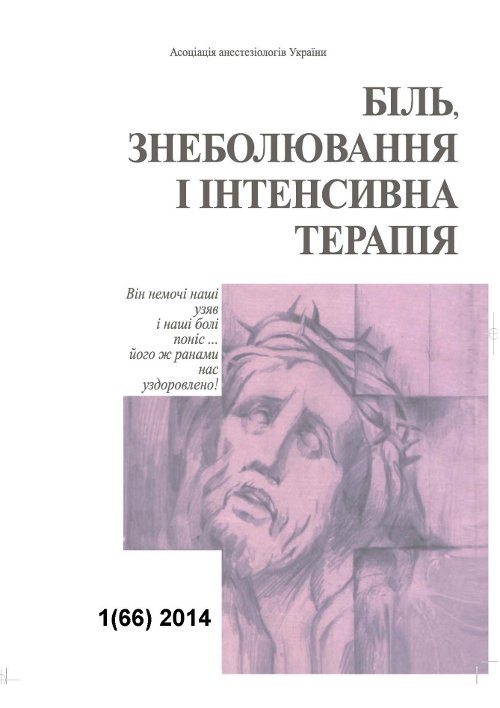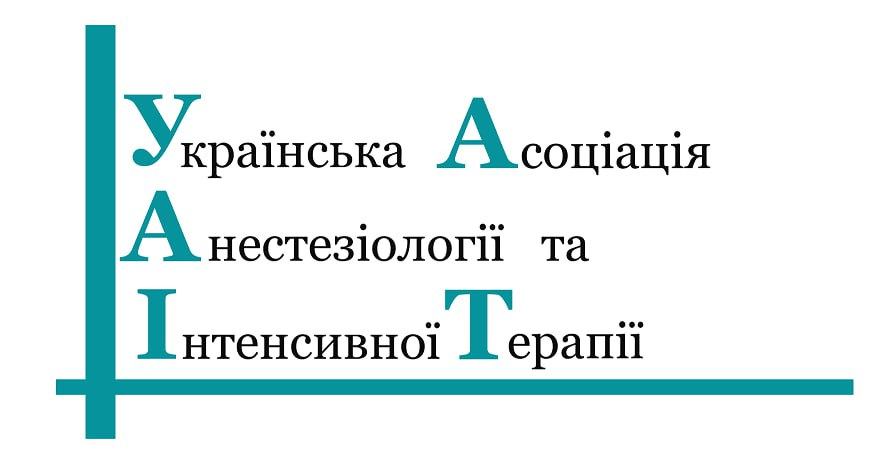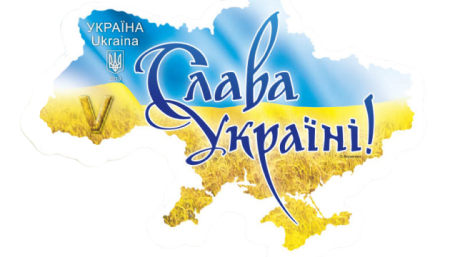Останнi рекомендацiї щодо застосування розчинiв гiдроксиетилкрохмалю. Огляд сучасної лiтератури
DOI:
https://doi.org/10.25284/2519-2078.1(66).2014.85614Ключові слова:
iнфузiйна терапiя, розчини гiдроксиетилкрохмалiв, показання, протипоказання, безпекаАнотація
Iнфузiйна терапiя є важливим компонентом лiкування практично всiх видiв шоку i взагалi iнтенсивної терапiї. У статтi обговорюються основнi проблеми вибору розчинiв для iнфузiйної терапiї. Акцент робиться на застосуваннi розчинiв гiдроксиетилкрохмалiв (ГЕК). Автори наводять короткi iсторичнi данi щодо розчинiв для iнфузiйної терапiї. Розглядають вплив молекулярної ваги розчинiв ГЕК на несприятливi ефекти iнфузiйної терапiї, проводять порiвняння ГЕК з кристалоїдними розчинами, наводять рiзнi данi про безпеку та ефективнiсть ГЕК в порiвняннi з альбумiном та iншими напiвсинтетичними колоїдами. Також наводяться останнi рекомендацiї щодо застосування цих розчинiв у складi iнфузiйної терапiї.Посилання
Westphal GA. How to guide volume expansion in severe sepsis and septic shock patients? Possibilities in the real world. Shock, 2013;39 Suppl 1:38-41. https://doi.org/10.1097/shk.0b013e31828faf4a
Myburgh JA., Mythen MG. Resuscitation Fluids. N Engl J Med, 2013;369:1243-51. https://doi.org/10.1056/nejmra1208627
Zampieri FG, Park M, Azevedo LC. Colloids in sepsis: evenly distributed molecules surrounded by uneven questions. Shock, 2013;39 Suppl 1:42-9. https://doi.org/10.1097/shk.0b013e31828faf82
Finfer S, Liu B, Taylor C, et al. Resuscitation fluid use in critically ill adults: an international cross-sectional study in 391 intensive care units. Crit Care, 2010;14: R185. https://doi.org/10.1186/cc9293
Van Der Linden P, James M, Mythen M, Weiskopf RB. Safety of modern starches used during surgery. Anesth Analg, 2013;116(1):35-48. https://doi.org/10.1213/ane.0b013e31827175da
Gattas DJ, Dan A, Myburgh J, et al; CHEST Management Committee. Collaborators (18) Fluid resuscitation with 6% hydroxyethyl starch (130/0.4 and 130/0.42) in acutely ill patients: systematic review of effects on mortality and treatment with renal replacement therapy. Intensive Care Med, 2013;39(4):558-68. https://doi.org/10.1007/s00134-013-2840-0
Gillies MA, Habicher M, Jhanji S, et al. Incidence of postoperative death and acute kidney injury associated with i.v. 6% hydroxyethyl starch use: systematic review and meta-analysis. Br J Anaesth, 2014;112(1):25-34. https://doi.org/10.1093/bja/aet303
Brunkhorst FM, Engel C, Bloos F, et al. Intensive insulin therapy and pentastarch resuscitation in severe sepsis. N Engl J Med, 2008;358:125-39. https://doi.org/10.1056/nejmoa070716
Patel A, Waheed U, Brett SJ. Randomised trials of 6% tetrastarch (hydroxyethyl starch 130/0.4 or 0.42) for severe sepsis reporting mortality: systematic review and meta-analysis . Intensive Care Med, 2013;39(5):811-22. https://doi.org/10.1007/s00134-013-2863-6
Zarychanski R, Abou-Setta AM, Turgeon AF, et al. Association of hydroxyethyl starch administration with mortality and acute kidney injury in critically ill patients requiring volume resuscitation: a systematic review and meta-analysis. JAMA, 2013 20;309(7):678-88. https://doi.org/10.1001/jama.2013.430
Bayer O, Schwarzkopf D, Doenst T, et al. Perioperative Fluid Therapy With Tetrastarch and Gelatin in Cardiac Surgery—A Prospective Sequential Analysis. Crit Care Med, 2013;41(11):2532-42. https://doi.org/10.1097/ccm.0b013e3182978fb6
Brunkhorst FM, Engel C, Bloos F, et al. Intensive insulin therapy and pentastarch resuscitation in severe sepsis. N Engl J Med, 2008;358:125-39. https://doi.org/10.1056/nejmoa070716
Kozek-Langenecker SA, Jungheinrich C, et al. The effects of hydroxyethyl starch 130/0.4 (6%) on blood loss and use of blood products in major surgery: a pooled analysis of randomized clinical trials.Anesth Analg, 2008;107(2):382-90. https://doi.org/10.1213/ane.0b013e31817e6eac
Cabrales P, Tsai AG, Intaglietta M. Resuscitation from hemorrhagic shock with hydroxyethyl starch and coagulation changes. Shock, 2007;28(4):461-7. https://doi.org/10.1097/shk.0b013e31804880a1
Simon TP, Schuerholz T, Haugvik SP, et al. High molecular weight hydroxyethyl starch solutions are not more effective than a low wmolecular weight hydroxyethyl starch solution in a porcine model of septic shock. Minerva Anestesiol, 2013;79(1):44-52.
Matharu NM, Butler LM, Rainger GE, et al. Mechanisms of the anti-inflammatory effects of hydroxyethyl starch demonstrated in a flow-based model of neutrophil recruitment by endothelial cells.Crit Care Med, 2008;36(5):1536-42. https://doi.org/10.1097/ccm.0b013e318169f19a
Van Der Linden P, James M, Mythen M, Weiskopf RB. Safety of modern starches used during surgery. Anesth Analg, 2013;116(1):35-48. https://doi.org/10.1213/ane.0b013e31827175da
Zaar M, Lauritzen B, Secher NH. Initial administration of hydroxyethyl starch vs lactated Ringer after liver trauma in the pig. Br J Anaesth, 2009;102(2):221-6. https://doi.org/10.1093/bja/aen350
Myburgh JA, Finfer S, Bellomo R, et al. Hydroxyethyl starch or saline for fluid resuscitation in intensive care. N Engl J Med, 2012;367:1901-11. https://doi.org/10.1056/nejmoa1209759
Inan N, Iltar S, Surer H, Effect of hydroxyethyl starch 130/0.4 on ischaemia/reperfusion in rabbit skeletal muscle. Eur J Anaesthesiol, 2009;26(2):160-50. https://doi.org/10.1097/eja.0b013e32831ac4a7
Kimberger O, Arnberger M, Brandt S, et al. Goal-directed colloid administration improves the microcirculation of healthy and perianastomotic colon. Anesthesiology, 2009;110(3):496-504. https://doi.org/10.1097/aln.0b013e31819841f6
Xiong L, Lei C, Wang Q, Li W. Acute normovolaemic haemodilution with a novel hydroxyethyl starch (130/0.4) reduces focal cerebral ischaemic injury in rats. Eur J Anaesthesiol, 2008;25(7):581-8. https://doi.org/10.1017/s0265021508004067
Kheirabadi BS, Crissey JM, Deguzman R, J et al. Effects of Synthetic Versus Natural Colloid Resuscitation on Inducing Dilutional Coagulopathy and Increasing Hemorrhage in Rabbits // Trauma. 2008;64(5):1218-28. https://doi.org/10.1097/ta.0b013e31816c5c6c
Bayer O, Reinhart K, Sakr Y, et al. Renal effects of synthetic colloids and crystalloids in patients with severe sepsis: a prospective sequential comparison. Crit Care Med, 2011;39:1335-42. https://doi.org/10.1097/ccm.0b013e318212096a
Osthaus WA, Witt L, Johanning K, Boethig D, Equal effects of gelatin and hydroxyethyl starch (6% HES 130/0.42) on modified thrombelastography in children. Acta Anaesthesiol Scand, 2009;53(3):305-10. https://doi.org/10.1111/j.1399-6576.2008.01863.x
Varga R, Török L, Szabó A, et al. Effects of colloid solutions on ischemia-reperfusion-induced periosteal microcirculatory and inflammatory reactions: comparison of dextran, gelatin, and hydroxyethyl starch.Crit Care Med, 2008;36(10):2828-37. https://doi.org/10.1097/ccm.0b013e318186ff48
Godet G, Lehot JJ, Janvier G, et al. Safety of HES 130/0.4 (Voluven®) in patients with preoperative renal dysfunction undergoing abdominal aortic surgery: a prospective, randomized, controlled, parallel-group multicentre trial. Eur J Anaesthesiol, 2008;25(12):986-94. https://doi.org/10.1017/s026502150800447x
Mittermayr M, Streif W, Haas T, et al. Effects of colloid and crystalloid solutions on endogenous activation of fibrinolysis and resistance of polymerized fibrin to recombinant tissue plasminogen activator added ex vivo. Br J Anaesth, 2008;100(3):307-14. https://doi.org/10.1093/bja/aem363
PRAC confirms that hydroxyethyl-starch solutions (HES) should no longer be used in patients with sepsis or burn injuries or in critically ill patients. 11 October 2013 EMA/606303/2013.
Vincent Jean-Louis and De Backer Daniel. Circulatory Shock. N Engl J Med, 2013;369:1726-34. https://doi.org/10.1056/nejmra1208943
##submission.downloads##
Опубліковано
Як цитувати
Номер
Розділ
Ліцензія
Авторське право (c) 2014 Ф. С. Глумчер, А. Н. Семянкив, Е. В. Стрепетова

Ця робота ліцензується відповідно до Creative Commons Attribution-NonCommercial 4.0 International License.
Автори, які публікуються у цьому журналі, погоджуються з наступними умовами:
a. Автори залишають за собою право на авторство своєї роботи та передають журналу право першої публікації цієї роботи на умовах ліцензії Creative Commons Attribution-NonCommercial 4.0 International License, котра дозволяє іншим особам вільно розповсюджувати опубліковану роботу з обов'язковим посиланням на авторів оригінальної роботи та першу публікацію роботи у цьому журналі.
b. Автори мають право укладати самостійні додаткові угоди щодо неексклюзивного розповсюдження роботи у тому вигляді, в якому вона була опублікована цим журналом (наприклад, розміщувати роботу в електронному сховищі установи або публікувати у складі монографії), за умови збереження посилання на першу публікацію роботи у цьому журналі.
c. Політика журналу дозволяє і заохочує розміщення авторами в мережі Інтернет (наприклад, у сховищах установ або на особистих веб-сайтах) рукопису роботи, як до подання цього рукопису до редакції, так і під час його редакційного опрацювання, оскільки це сприяє виникненню продуктивної наукової дискусії та позитивно позначається на оперативності та динаміці цитування опублікованої роботи (див. The Effect of Open Access).








